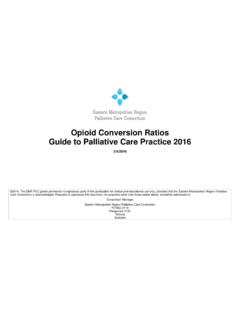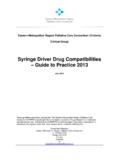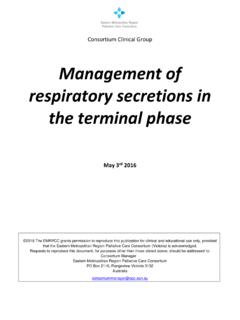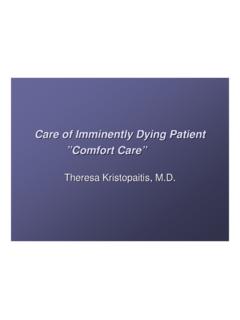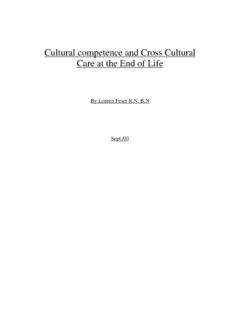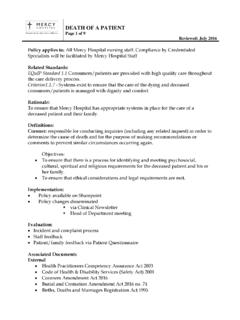Transcription of Guidelines for the management of respiratory secretions in ...
1 Eastern Metropolitan Region Palliative care Consortium (Victoria) Clinical Working Party Guidelines for the management of respiratory secretions in an imminently dying patient December 2010 2010. These Guidelines have been copyrighted. The EMRPCC grants permission to reproduce parts of this publication for clinical and educational use only, provided that the Eastern Metropolitan Region Palliative care Consortium (Victoria) is acknowledged.
2 Requests to reproduce this document, for purposes other than those stated above, should be addressed to: Consortium Manager Eastern Metropolitan Region Palliative care Consortium PO Box 227, Nunawading VIC 3131 Australia Guideline review due: February 2013. 2010 Eastern Metropolitan Region Palliative care Consortium (Victoria) p2 Background: Terminal respiratory secretions (known as death rattle or noisy breathing ) are often observed in an imminently dying person.
3 Despite the symptom occurring in 23 - 92% of patients (1) there is a lack of robust research to guide its assessment or management . The cause of terminal respiratory secretions is unproven, but is considered to be due to a pooling of respiratory secretions that occurs as a person becomes weaker, loses consciousness and the ability to cough or swallow normally (2). Family members often express concern that terminal respiratory secretions may be distressing to the patient, and they require ongoing support and education to allay their anxieties.
4 Rattle Intensity Score (5) A scoring tool may be used in clinical documentation Key points to remember The death rattle is a strong predictor of death after the death rattle commences, median survival is 23 hours. (3) The literature search conducted for these Guidelines showed no anti-secretory medication to be consistently better than another. Providing quality care and support to the patient s family is critical, including bereavement care . Mouth care and position changes will maximise patient comfort.
5 Clinical experience shows suctioning can be very uncomfortable for the patient and cause (8). If suctioning is felt to be needed, gentle oral suctioning only maybe appropriate. Implement the management flow chart (p3) when the symptom is detected. Medication is not always required. Regularly assess the patient s clinical situation and response to any medication administered. Guidelines for initiating medication: 1) Identify death rattle as soon as it starts.
6 Medications are most effective when started at a rattle score of 1 (see scoring tool above) (3) 2) Assess the hydration of the mouth as medication may exacerbate dryness. 3) Continue pharmaceutical treatment for 24 hours. Effectiveness improves with time (3) 4) If sedation is required consider using drugs which are tertiary amines (Atropine and Hyoscine Hydrobromide/Hyoscine ) (3, 4) 5) Drug selection & prescribing is based on the differing pharmacological profiles, prescriber preference, accessibility and the cost of medication.
7 (7) Abbreviations used in the flow chart: mg = milligrams 0 Not audible 1 Only audible near patient 2 Clearly audible at the end of the patients bed in a quiet room 3 Clearly audible at a distance of about in a quiet room 2010 Eastern Metropolitan Region Palliative care Consortium (Victoria) p3 Has it been effective? The patient is dying with noisy respiratory secretions ( death rattle ) GENERAL APPROACH Patient care : Nurse the person on their side, reposition to other side every 3-4 hours.
8 Elevate the head of the bed slightly, retain a position of comfort Provide frequent mouth care (every 1-2 hours). Family care : Explain how & why noisy secretions develop, emphasising it is a normal part of the dying process. Give reassurance that the noise & secretions are not distressing for the patient Provide the EMRPCC family leaflet on this symptom or other appropriate supportive literature. Are the noisy secretions still problematic? No Continue with the general approach Yes Maintain the general approach (as above).
9 Maintain the general approach as outlined above. Repeat subcutaneous dose in 4-6 hours as needed. If ongoing doses of medication are required then consider using a continuous subcutaneous infusion of the effective drug. Atropine - mg /24 hours (9) Glycopyrrolate - mg /24 hours (6) Hyoscine Butylbromide (Buscopan) 60 - 80 mg /24 hours (6) Hyoscine Hydrobromide (Hyoscine) - /24 hours (6) Yes No Any of the following drugs (listed alphabetically) are suitable for subcutaneous administration, depending on availability & preference Atropine (can be sedating) - stat.
10 Or Glycopyrrolate stat, or Hysocine Butylbromide (Buscopan) 20mg stat, or Hysocine Hydrobromide (Hyoscine) stat Provide ongoing support to family, reiterating it is a part of the dying process and not distressing for the patient. Continue with the general approach (as outlined above). An alternate drug or dose may be used but is unlikely to relieve the noise. Address the grief and bereavement needs of carers & family. 2010 Eastern Metropolitan Region Palliative care Consortium (Victoria) p4 DISCLAIMER This document is to be printed in colour in its entirety.

